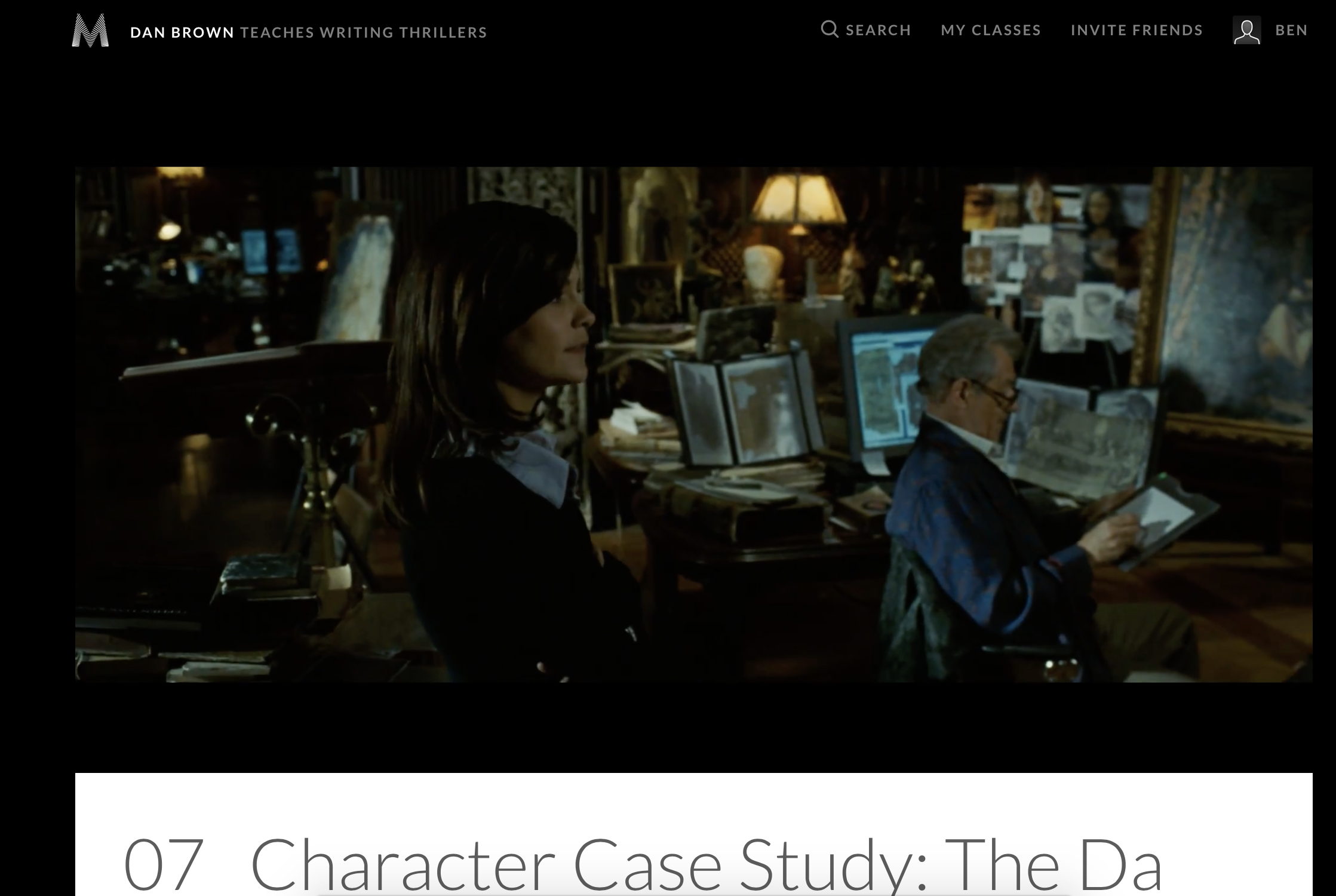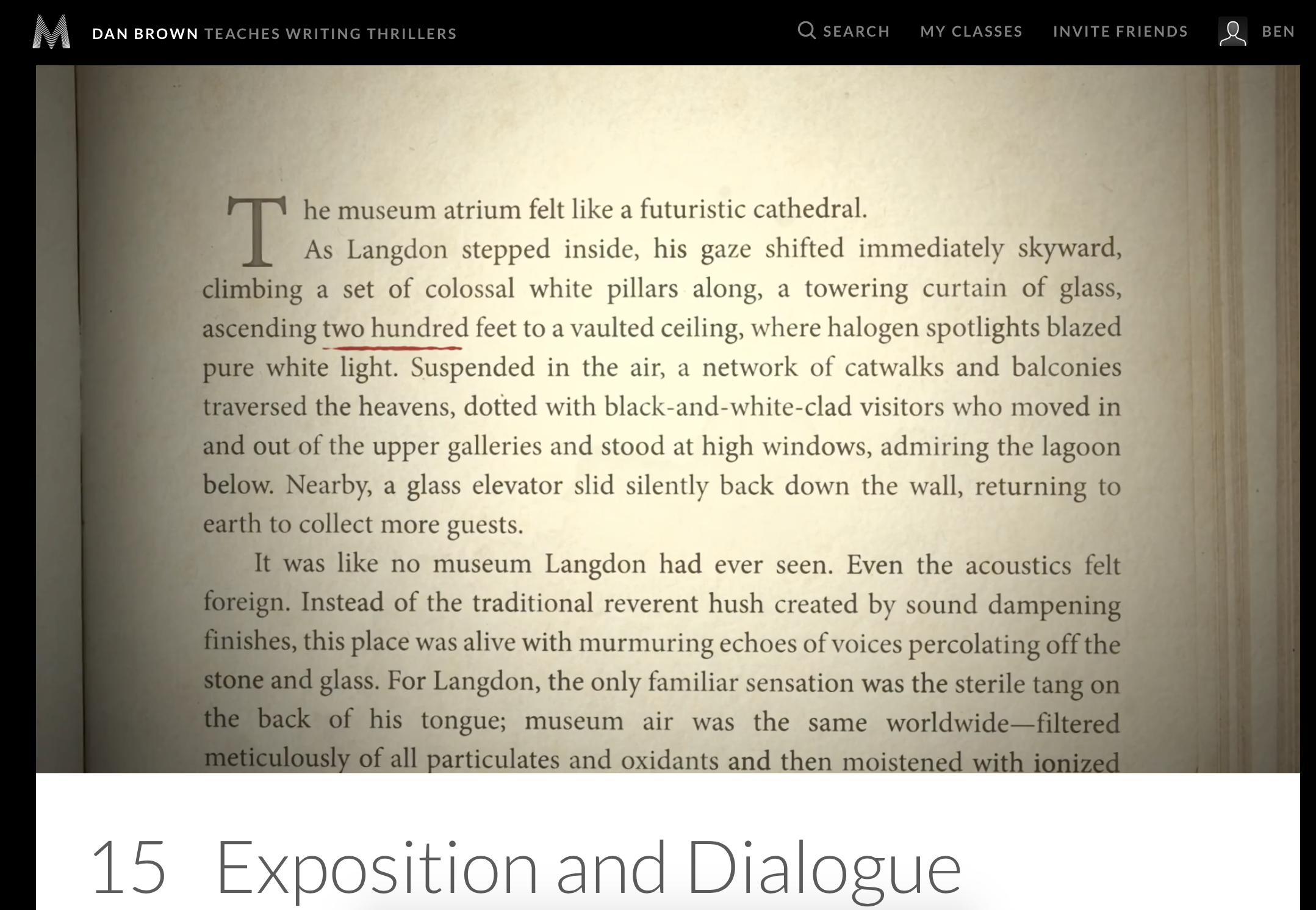I’m always impressed when I see a new MasterClass launch. But every so often there’s one that blows me away. Like the Dan Brown Teaches Writing Thrillers MasterClass.
It’s those classes that scare me. The classes where I didn’t even really know the teacher, nor cared about the subject, often turned out to be the best masterclasses I’ve ever taken. But when it comes to learning from someone I personally admire in the field I want to advance in, then I go in wary…
Luckily the Dan Brown Teaches Writing Thrillers MasterClass shattered all expectations and ended up being a phenomenal writing class, helping me restart my fiction career after a long layoff.
The Dan Brown Teaches Writing Thrillers MasterClass is officially my personal favourite MasterClass.
Here’s why…
Dan Brown Teaches Writing Thrillers MasterClass Review
The Dan Brown Teaches Writing Thrillers MasterClass kicks off with Dan making this promise:
At the end of this MasterClass, I am going to admit something to you that I have never admitted to anyone on Earth. I’m also going to show you an artefact that nobody except me has ever seen. And that is your first lesson in suspense.
You know this is going to be a fantastic masterclass right from the start.
The introduction is as suspenseful as any of Dan Brown’s books.
It’s also beautifully produced with the camera rolling over different artefacts in what I’m assuming is Dan Brown’s home while he muses on what books mean to different people and his aims with this masterclass.
That promise isn’t a cheap gimmick either by the way.
Sure, it hooks you, but I actually forgot all about Dan’s promise as soon as the course got going as there was just so much value in everything he was saying. And when it finally does come time for Dan to reveal his secret, boy is it something.
So the MasterClass starts with Dan Brown telling us his aims.
Dan’s aim is not to give us specific ideas but to give us a roadmap to turn ideas we come up with into a story – specifically targeting thrillers, but it should help writers of all genres because what makes thrillers work is at the core every single art form (not just novel writing).
Dan talks about when he was starting out as a writer and how he got a lot of various theoretical advice like…
- “show, don’t tell”
- “write what you know”
- “write a page a day”
- “write what you’re passionate about”
And while there’s truth in all of that, the reality is it’s not that helpful when you’re trying to sit down to figure out how to put a book together.
But this class is designed to be different – and, having completed this masterclass, I can definitely confirm that!
This masterclass is about the nuts and bolts of…
- how you build tension
- how you create characters
- how you put a story together
- how to write a finale and an opening
- how you even decide what to write about
- how to weave multiple plot-lines together in a way that your reader can follow.
And so much more.
Dan’s hope is that this class provides some truly practical tools to help writers create stories – and he also hopes that we have a little fun along the way.
Without a doubt, having got to the end and just about to start my second re-watch, this masterclass is the BEST writing class I have ever taken.
This MasterClass is insanely practical and insanely fun.
I’m going to get into a few of the different things I liked about the Dan Brown Teaches Writing Thrillers MasterClass in this review.
But first let’s look at the spec of this MasterClass.
What you get in the Dan Brown MasterClass:
You currently get 19 video modules of close to 5 hours total lesson footage from Dan Brown.
These lessons cover everything you need to get your from start to finish with your novel.
Everything from finding ideas, choosing locations, creating heroes and villains, research, and creating suspense to dialogue, exposition, point of view, editing, and so much more.
On top of this, Dan Brown is available in something known as Office Hours.
Basically you can submit questions about writing or the course and Dan will answer them!
Because this masterclass is new, he hasn’t answered any questions yet – I think your chance of getting a question answered is much higher if you get in early.
You also get this awesome accompanying workbook, which is structured with tons of information, like a chapter in a book, building on everything in the video module but giving books and different things to explore.
Then you have coursework, which is divided into two sections: writing exercises, which are for everyone and give you ways to practice the skills Dan Brown outlines in the videos. And also the “for your novel” section, which is tailored to writers who want to begin, or already have begun, writing their novel.
You’re asked to keep a notebook devoted to the course and the lessons and assignments are designed to build on top of each other so along the way you’ll discover your setting, develop your characters, build your story, and even research your subject matter.
I’ve got to say that I’m really blown away by the workbook.
The MasterClass workbooks are almost always top quality, but the Dan Brown one is in a class of its own. I’ll be printing this out and sticking to it closely as my writing bible for the next year.
The Dan Brown MasterClass kicks off with a discussion on the anatomy of a thriller.
Suspense is all about making promises. It’s about telling a reader, ‘I know something you don’t know. And I promise, if you turn the page, I’m going to tell you.
We’re only one lesson in and you can see the other students all saying this class is already better than any other class they’ve taken… What does that tell you?
In this part of the course, we get into what Dan thinks about whenever he sits down to write a thriller: the three C’s…
The contract, the clock, and the crucible.
This was immediately fascinating to me.
Although I’ve been writing a long time, I’ve not thought of something as basic as making a contract with a reader and keeping your promise.
Actually looking back over stuff I’ve written, I can see they aren’t too strong because it’s hard to even define what the contract is at the beginning.
Dan uses an example when writing The Da Vinci Code and how he had only a few days to write the ending before it went to press and there were 17 promises that needed to be tied up and resolved.
The idea of the crucible was equally fascinating (made especially easy to understand through Dan’s example from the movie Jaws) and yet in all this time I’ve been writing, taking writing classes, and reading books on writing…
I’ve not heard this concept put in this way before!
So we’re not even five minutes into the first lesson in the Dan Brown MasterClass and, despite it being targeted tremendously well at first time writers, me as an intermediate writer is learning new things already.
We get into how to apply time pressures (like the ticking bomb in the Vatican in Angels and Demons), and all about pace, promises, and suspense.
This is all about asking a lot of questions very quickly and giving answers very quickly – if you want to write thrillers like Dan Brown, this section is going to get your mindset where it needs to be to do so.
Dan gets into so much stuff so quickly – but the thing that particularly stuck out was his discussion on how critical it is to front-load as many questions as you can towards the front of your book. And then he shows you how and when to answer them in order to achieve different effects.
We also get a ton of valuable insight in how to read critically in the thriller genre (and if you’re using the accompanying workbook – which you should – you’ll get more book recommendations that you know what to do with).
We hear Dan Brown’s reading advice and we hear about his own reading habits.
“Your job as a writer: give the reader what they want in a way they don’t see coming.”
If you struggle to find ideas, then the next module is hands down the best lesson on how to find ideas that I have ever encountered.
Dan Brown gets into these phenomenal discussions about trusting your taste, writing what you want to know, starting with the world, how to identify your sole dramatic question, finding a moral grey area, thinking like a philosopher but writing like a thriller writer, focusing on the “how” instead of the “what”, and so much more.
I really loved this section because it kicks off with how to bust out of the “write what you know” cliché.
A lot of people say they’re an accountant, they don’t want to write what they know but they’re fascinated by underwater archeology (as an example) – Dan Brown shows you how to pursue that and make THAT the thing that you know.
Only two lessons in and I was bursting with ideas and an itch to write.
Dan gives you a bunch of fascinating tools to jump-start a story.
There really are A LOT of tools.
The jump-start tool I particularly liked was when Dan Brown used Inferno as example and talked about fusing the very old and the very new. The very new – overpopulation and genetic engineering. The very old – Dante’s Divine Comedy. When he fused the two, he had Inferno.
This masterclass is so tightly structured, so well-delivered, so endlessly fascinating, so incredibly motivating…
I’m in disbelief.
There are a lot of talented writers out there but there isn’t an overlap with being able to teach the craft. Yet if you didn’t know this was Dan Brown, you would fully buy him as a top university professor (obviously he does have teaching experience and it shows incredibly well in this masterclass, from how the syllabus is arranged to how he explains all the principles).
This is one of the rare occasions where I’ve found a writing class to give actually CONCRETE and PRACTICAL advice about idea generation.
And I’ve never heard this advice given before.
You get a really tremendous array of tools, techniques, tips, and hacks Dan Brown has come up with in order to generate ideas, even when you want to write about a world you don’t understand.
And I really loved how he used Ian Fleming’s writing as an example to teach you how to take the pressure off yourself when coming up with an idea.
Obviously it wouldn’t be a Dan Brown MasterClass if there wasn’t a meaty section on choosing locations.
I’m going to sound like a broken record, but I freaking loved this section too.
Locations not only function as characters that have personalities, they can function as pillars of your structure.
Here we learn how choosing the right location will do a lot of the heavy lifting for you.
For example, you can write a conversation that takes place in a Denny’s restaurant, but if you set that same conversation in the Guggenheim Museum in Bilbao in the shadow of a 30-foot tall black widow spider, the conversation suddenly feels more interesting.
The lesson on creating heroes and villains was also breathtaking, with a lot to dig into – I particularly loved hearing Dan’s advice about how and why you should write your villain first.
We learn how to make an interesting villain – very illuminating stuff. I also loved how to introduce a villain, an aspect I didn’t think too much about.
Then Dan breaks down what makes a good hero with examples ranging from James Bond, Indiana Jones, and, of course, Robert Langdon.
All while the video lessons are running, I keep pausing and making notes and consulting the workbook and I’ve got to say…
The amount of depth in the workbook is staggering.
People ask, “What’s better: a video course or a book?”
Well, if it’s a video course alone I’m still going for the video course. But with this masterclass you get the course and the book, which makes for an absolutely lethal combination when it comes to sharpening your writing skills.
I really adored the section on universal character tools.
Another aspect I personally haven’t given much consideration in my writing is that of secondary characters.
I think it’s extraordinary that Dan Brown, as well as hitting all the important aspects I have thought about, gives SO MUCH attention to stuff that I really skipped over in my writing.
I simply haven’t thought much about secondary characters. As such, looking back on mine, they’re all weak and don’t serve the story or main character as well as they should.
Here Dan Brown gives some great advice on how to create secondary characters that matter.
I also loved Dan’s advice that isn’t typical of the whole “create 20 biographies of 20 characters before you even start writing”.
Dan’s way of doing things is way more organic and appeals to me.
I have tried the biographical approach and I do like it (others probably like it more) so I’m keen to try out his approach to see if it fits me better.
Dan Brown goes into how you don’t need to know every single thing about every single character…
But there is ONE thing that you DO need to know about each character.
I already knew this information but it was a nice refresher and I enjoyed the way Dan put it.
Funnily enough I learnt this from another writer in the MasterClass catalogue (Aaron Sorkin) so I’m sure there are plenty of people taking this class that won’t know this and it will be new to them.
A little aside: Get the All Access Pass if you really want value for money when it comes to learning how to write.
MasterClass is the best writing suite on the planet if you have the All Access Pass…
Where else can you learn from Margaret Atwood, Malcolm Gladwell, David Mamet, Aaron Sorkin, Judy Blume, James Patterson, R. L. Stine, Shonda Rhimes, Dan Brown, and more in one place?
So I’m really impressed with all the tools in this MasterClass.
In the universal character creation section, you get a bunch of different cool tools you can use to instil your narrative with tension with literally no effort.
There’s so many tools when it comes to character creation, but one in particular really stood out for me.
It’s all about adding one little sentence when introducing a character that will suddenly give the reader a ton of emotional baggage and imagination.
Once again, this is advice I haven’t heard anywhere else.
I feel like I’ve been given a bunch of secret cheat codes to the game of being a writer.
There are too many tools regarding creating characters in this section.
I can’t list them all.
But another one I really liked was when Dan starts teaching about how to craft internal monologue and how to make your character smarter than you are.
Then we get into a really awesome character case study using The Da Vinci Code.
By this point in the MasterClass, I simply couldn’t believe how much value I was getting.
And even though I wasn’t even half way through, and this is a long course, I was feeling sad that it would have to end at all!
Dan takes four different characters from The Da Vinci Code, using footage from the Ron Howard and Tom Hanks film, and breaks them apart to show you how different types (like the Muscle or the Puppet Master) can be used to create suspense and drive the narrative forward.
Another section I adored was all about research.
In fact, Dan’s advice on research is so comprehensive that it’s split into two parts.
Dan Brown breaks down the different research stages and how to approach each stage from pre-idea stage all the through the story.
I loved hearing how Dan structured his own research for his books and it was particularly interesting to hear what he was reading during the research stage of Origin.
I also really loved how he approaches setting research and how to use different settings as plot pillars – again, something I never thought much about before, but now I’m really thinking about it in depth.
It was also great to hear how to prepare when it comes to asking real people questions – what to do BEFORE you connect with specialists and was also great hearing how Dan structures his research trips to locations.
You’ll definitely want to scout out some locations and follow Dan’s approach after this section. It really got me itching to start buying plane and train tickets to far-flung locations.
Then we get into what is, without a doubt, one of the best modules in the Dan Brown MasterClass:
The lesson on building a story from the ground up.
This module is easily worth the price of entry alone.
This module solidifies the Dan Brown Teaches Thriller Writing MasterClass as one of the best MasterClasses in the catalogue.
Dan walks us through the process of creating the world, asking the questions, figuring out who the characters are, and putting it all together.
This module is absolutely superb, and as close to hand-holding as you’re ever going to get as we learn how to go from idea to completed thriller in a 13-step process.
There is simply no way you can’t not write a book after this lesson.
You absolutely WILL WRITE A BOOK thanks to this lesson alone.
Then we get into a two-part section on creating suspense.
Again – another very concrete toolkit with real hacks you can use to instantly create suspense.
You’ve got templates of actual substance you can apply immediately.
You’ve actually got a checklist of things you can introduce that will immediately create suspense.
After giving us a bunch of cool tools that you’ll want to try immediately, we then look at Origin together to see examples of how Dan makes promises that ramp up the novel’s suspense.
Then we get into something very cool.
Dan Brown shares with us the prologue to a novel he never wrote.
It’s a young adult novel and he just wrote the prologue for fun, which shows us how to build suspense in a very abrupt way.
We learn how to suck the reader in immediately in the beginning of the chapter and how to craft cliffhangers that keep them turning the pages.
Dan gives a close reading of the endings of a chapter from The Da Vinci Code and breaks it all apart so we can then do the same with our own chapter endings.
Dan goes deep into the art of withholding information.
Withholding is not simply a matter of not saying something – there are right (believable) ways to do it and wrong ways to do it.
Dan shows us the right way to withhold information.
Another phenomenal section was all about writing chapters and scenes.
We learn the specific goals Dan approaches each chapter with and the technique he uses to keep to that goal.
Once you know the framework for each chapter, Dan shows you how to step back and have some fun with it.
Once again with Dan deconstructing scenes from The Da Vinci Code so we can see the principles in action.
Like every module, there is just SO MUCH stuffed in here.
It’s hard to isolate just one aspect of each module that I love because my notebook is overflowing and I’ll need to rewatch A LOT.
But in this lesson I particularly loved Dan’s advice on how to think musically about each chapter.
I also loved his techniques of painting characters into a corner in order to find exciting ways to get them out (makes sense if you watch) and also loved learning how to create puzzles.
Then we get into selecting and utilising point of view.
This module is a masterclass in POV and better than I’ve ever seen it outlaid before.
You get tons of hacks for finding the right POV but also ways to show the reader who is thinking what and different times.
Again all the nuts-and-bolts tips are backed up by case studies using Dan Brown’s books.
The exposition and dialogue module was also tremendous.
Noticing a pattern here?
Even though I’ve written for well over a decade, read thousands of books, and even studied literature at Oxford, I hate grammar.
But this lesson has a ton of different tools and tips for making exposition and dialogue more suspenseful that necessarily required a discussion of grammar – yet this was the easiest to understand grammar lesson I’ve ever experienced and you can apply everything immediately.
If you ever found the nitty gritty of the English language difficult, don’t worry or be put off by the prospect that there might be tons of it in this course because Dan makes it extremely digestible and easy to apply.
The editing and rewriting section was also tremendous.
Again, lots of great advice here that I haven’t heard before (and I thought I’d heard all the editing advice there was.)
I particularly loved Dan’s colour-coding system for editing and will definitely be using that myself going forward with my own writing.
This system is designed to gamify the editing process, removing the tedium from it and making it fun.
After you get through all the nuts-and-bolts stuff about craft, Dan then goes into everything covering the reality of writing as a career.
I loved the module on protecting your process.
When Dan was starting out as a novelist, he was overwhelmed, so he put a sticky note on his computer that said: “Protect the process and the results will take care of themselves.”
Dan then gets into exactly what that process is – and how you can create your own process.
Because your job is not to write a novel.
Your job is to park yourself in the chair every day and do the very, very best you can to create a novel and the pages will eventually pile up.
If you’re feeling intimidated by the prospect of writing a novel, the practical tools Dan outlines in this module will take that away and you’ll feel way more courageous.
I loved hearing about writing spaces, and it was very interesting to hear the places Dan embarrassedly admits to writing The Da Vinci Code and Deception Point in.
If you’re wondering whether to write X amount of pages a day or go for the time approach (X amount of hours), you’ll find out which one is better and why.
This made me completely switch my daily writing approach.
It just makes way more sense after hearing Dan’s explanation.
There’s also great advice on how to have your creative engine running as soon as you arrive at your desk each day.
No more staring at a blank page for me after hearing Dan Brown’s advice.
Seriously, in a lot of courses, when it comes to talking about creativity, process, and inspiration, the advice almost always sounds generic and wishy-washy.
But, like the rest of this masterclass, I’ve learnt concrete tools that I’ve never heard of before that sound freaking amazing and I can’t wait to try them out.
Everything from how Dan structures his writing time to how he approaches the beginning of whole novels – I just can’t believe how invigorated I feel to start a new novel, especially at a time in my life where it seriously felt like I wouldn’t write again.
The section on life as a writer was a very motivating module.
Not motivating in a pump-up Tony Robbins way.
But motivating in a hard cold truth paradigm-shattering sort of way.
The Dan Brown Teaches Writing Thrillers MasterClass is my favourite MasterClass.
Every other student enrolled is in agreement.
There’s only one thing I can say…
Wow.
Now I’m diving back in and getting cracking on my next novel.
You can check out the Dan Brown MasterClass here.
If you’re a writer, it will be one of the best investments you will make for your craft.




















